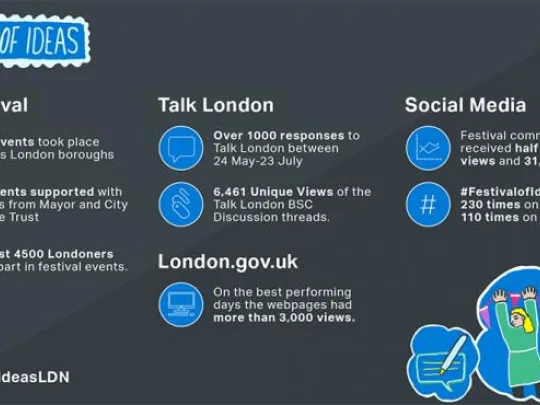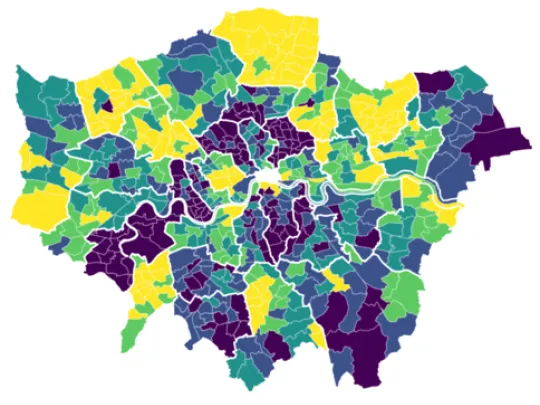
Key information
Publication type: General
Publication date:
Contents
6 sections
1. Context
The Festival of Ideas (FOI) events created a space for communities to explore:
- what strong communities look like
- where they come together
- what’s needed for recovery from the pandemic
79 event organisers gave feedback about what they learnt.
Event organisers and stakeholders contributed to the analysis of this feedback. The process was facilitated by a research consultant.
The learning is being used to inform the design and development of the ‘building stronger communities’ mission as part of the GLA London Recovery Programme.

The Festival
104 Events took place across London boroughs
56 Events supported with grants from Mayor and City Bridge Trust
Almost 4500 Londoners took part in festival events
Talk London
Over 1000 responses to Talk London between 24 May - 23 July
6,461 Unique Views of the Talk London BSC Discussion threads
London.gov.uk
On the best performing days the webpages had more than 3,000 views
Social Media
Festival communications recieved half a million views and 31,000 clicks
#FestivalofIdeasLDN used 230 times on twitter and 110 times on
Instagram
2. Participatory workshops
Two workshops were attended by representatives of more than 20 community groups, charities and civil society organisations involved in the Festival of Ideas.
In workshop 1 (October 4th 2021), participants
- Learnt about the insights emerging from the GLA festival of ideas
- Contributed to the analysis of the feedback gathered from events
- Identified key insights and discussed what makes a stronger community.
In workshop 2 (October 18th 2021), participants
- Reviewed a synthesis of the findings as to what makes a stronger community
- Learnt more about and highlighted how they could contribute to the GLA’s shared action plan
- Discussed what they needed to contribute further and how to continue the relationship
3. Stronger community themes
The themes define how communities, organisations and the GLA can actively collaborate to actively cultivate a stronger community.
They are based on:
- Independent thematic analysis of feedback
- Collective analysis and discussion with event organisers to interpret the analysis
- Cross referencing with recent research to measure the strength of communities
4. What are strong communities?
Together, we have identified 7 key elements of strong communities.
- Services meet local needs
- Opportunities to come together
- Places and spaces for the community
- Voice and ownership
- Commitment to diversity and inclusion
- Safety
- Funding and support
4.1 Services meet local needs
A strong community is one in which services are accessible, equitable, responsive and representative of diverse and changing community needs. They are trusted by the community.
4.1.1 Access to services: Detail
- Includes public services (council services, education, housing, health, and social care) and services provided by charity and community groups.
- There should be services to meet essential needs and build community.
- Services needed are not the same everywhere, there is no ‘one size fits all’.
- Services are fundamental to supporting communities to thrive when they:
- Provide essential and accessible support
- Respond to specific local needs
- Relevant to community needs identified by communities themselves
- Tackle structural inequalities
- Support the making of community
- Have the trust of the community
- Are designed and delivered by and with the communities they are for.
4.1.2 Festival of Ideas event organiser feedback: “What did you learn about how Londoners imagine strong communities?”
"[A strong community] should mean living as long and as healthily as everyone in the country. It should mean full employment and social justice for all, with key and essential services, provided not-for-profit. Many times grassroots organisations have the trust of the community. There should be adequate hubs for ALL residents to share the growing regenerated changes happening throughout our boroughs."
4.1.3 Festival of Ideas event organiser feedback: “What did you learn about how Londoners imagine strong communities?”
"Too often, the volunteers and the wide range of service users we work with have felt that they are sought for consultation, but not deemed good enough to create solutions for the challenges faced by the whole community."
4.2 Opportunities to come together
A strong community has opportunities to come together and connect with others based on a shared interest, identity, experience or activity. Communities actively support one another.
4.2.1 Opportunities to come together: Detail
- Social activities form the basis for social connections and future supportive relationships.
- Formal or social events and activities build a sense of belonging or offer mutual support.
- The community should play an active role in defining and delivering opportunities.
- Creative, artistic, music, physical activities, entertainment and food often to draw people in, especially if they are free. They give a sense of purpose and reason to come together.
- Voluntary and community organisations playing a key role in creating opportunities to come together, as well as supporting people to access these opportunities.
- Some communities have a shared identity, but need funding, space and purpose to come together again. Others need impetus to come together and forge a sense of community.
4.2.2 Festival of Ideas event organiser feedback: “What did you learn about how Londoners imagine strong communities?”
“Coming together is valuable for communities. It helps make sure people belong, have a good life, have fun, are safe. It doesn't happen enough and is really important after the pandemic.
However, communities are not mixing naturally - they need to be pushed to make this happen. This is even more important post-COVID - we need to keep working together.”
4.3 Places and spaces for the community
Stronger communities have places and spaces that enable communities to come together, participate in community activities and access services.
4.3.1 Places and spaces: Detail
- Places and spaces for the community to come together include a range of buildings, online spaces, high streets, parks, transport hubs, schools and others venues offering space for non profit, public and commercial use.
- Community venues do not necessarily need to be dedicated buildings or fixed locations (as long as there are spaces available regularly).
- Community spaces enable people to come together, access services and participate in community activities. They become focal points for a range of communities.
- They can also be online, although there is a strong desire to reconnect in physical locations following the social isolation of lockdown during the COVID-19 pandemic.
- Community spaces should be free (or funded), safe, accessible and inclusive. They feel relevant and in-keeping as a focal point for the community to come together.
- People coming together socially define and build a community place / space.
4.3.2 Festival of Ideas event organiser feedback: “What did you learn about how Londoners imagine strong communities?”
“Community is more than just a building. Buildings may be an important feature of the community, but the community is made by people. Whilst prayer services may be what often brings our communities together, it is the baby groups and other social activities which make the community. Strong communities are about strong relationships, with everyone feeling like they have a part to play.”
4.4 Voice and ownership
Strong communities have voice and ownership, taking responsibility for building their community, actively express their views and shaping the future of their communities.
4.4.1 Voice and ownership: Detail
- Communities actively participate in building the community they want to be part of, mobilising around a shared purpose and coming together to achieve this.
- Communities also take ownership and responsibility to improve the future of their community, acting to influence change in community activities, services or policy.
- A wider sense of inclusion, belonging and safety is vital to community members and groups feeling able to express their views, to be heard and influence change.
- A lack of trust in public institutions and/or community organisations, structural inequalities and a history of being consulted (without evidence of being heard) are barriers to a strong community with voice and ownership to influence change.
- Bringing people together across different communities (not just in silo’s) helps create a sense of shared vision (and a broader community identity) and a collective voice.
- Crucial to recognise that everyone has strengths and brings valuable perspectives.
4.4.2 Festival of Ideas event organiser feedback: “What did you learn about how Londoners imagine strong communities?”
“Communities come together with a shared vision and goal: to make the world a more enjoyable place- between people and for the environment. Giving people a voice, creates better environments for people to then develop closer relationships with each other. Breaking bread together (we had food and drink) enables those conversations to begin.”
4.5 Commitment to diversity and inclusion
Strong communities have a commitment to diversity and inclusion ensuring that efforts to build communities address community cohesion, inclusion, accessibility and structural inequalities.
4.5.1 Diversity and inclusion: Detail
- Communities largely come together around shared identities, backgrounds, experiences, locations and interests to create a shared sense of belonging.
- London is an aspirational community of shared identity, where diverse communities are recognised and celebrated.
- There is a risk of communities coming together in siloes. It is vital that there are varied opportunities to bring people together across different communities.
- Efforts to bring communities together need to focus explicitly on equality, diversity and inclusion. This will be beyond the remit of a single event or community and this should be explored collectively.
- Bringing different communities together can be hard and fraught with tension. It takes people dedicated to making this happen (along with money, resources, support).
4.5.2 Festival of Ideas event organiser feedback: “What did you learn about how Londoners imagine strong communities?”
“Like a garden where different flowers of different colours and smells grow side by side and together increase beauty of the garden. There will be no discrimination, no racism, no misunderstanding, no difference between black and white, poor and rich, people of different communities live together peacefully and participate in building the community stronger. Communities come together through activities.”
4.6 6. Safety
Strong communities feel safe for those who live there, including safe from crime, persecution, racism and abuse. Communities are inclusive and community members feel safe expressing their views and identities.
4.6.1 Safety: Detail
- People feel safe when they are secure and happy where they live.
- Strong communities are safe and feel safe for those who live there, including safe from crime, persecution, racism and abuse.
- When communities lack trust in the police and criminal justice system, they do not feel safe to come together, are more likely to exist in isolation or in conflict.
- People also need to feel safe expressing their views, having a voice and know that they will be listened to or heard.
- Key challenges include inequality, racism, discrimination, a lack of trust of public services.
- Safety is interwoven with a sense of belonging to a community. However, diversity thinking needs to underpin this. Some communities are less inclusive of different identities.
- A lack of trust, understanding and connections between communities can undermine safety.
4.6.2 Festival of Ideas event organiser feedback: “What did you learn about how Londoners imagine strong communities?”
"We are able to exist in a space where there is no need to explain our identities."
4.7 Funding and support
Strong communities have funding and support for people, community groups and organisations to lead initiatives and come together, with access to support that helps strengthen their efforts.
4.7.1 Funding and support: Detail
- Resources and funding enable communities to come together and support one another.
- Costs include venue hire, food, publicity, event administration, insurance and support.
- Access to spaces, places or venues that are accessible, affordable, inclusive and enable communities to come together is a specific challenge faced by many communities.
- Organisations need longer term or regular funding to come together (beyond one off events) in order to focus on building stronger communities.
- Some spaces and assets locally are underutilised, (e.g. schools after school hours).
- It is important funding is given by trusted organisations, underpinned by equality, accessibility and community needs. This should recognise expertise in communities and ideally share power for decision making with communities.
5. The London Civic Strength Index
The London Civic Strength Index helps London boroughs and organisations support discussions about the strengths of their communities and consider how build on them.
It was developed by the Young Foundation with funding by the GLA and informed by the views of Londoners captured during the Festival of Ideas.
The themes identified here align with the index.

Figure 5.1
London Civic Strength Index: Ward-level map of the overall civic strength scores - London Civic Strength Index interactive version.